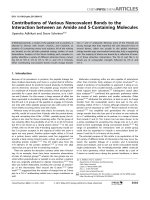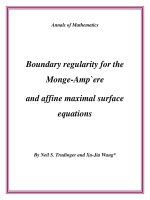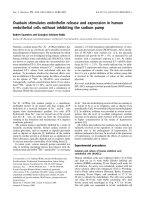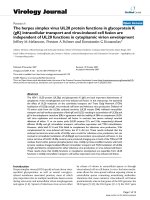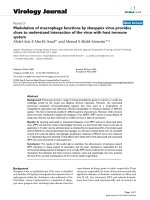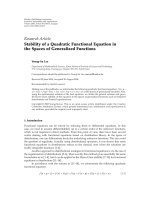Subextension of plurisubharmonic functions without changing the Monge Amp ere measures and applications
Bạn đang xem bản rút gọn của tài liệu. Xem và tải ngay bản đầy đủ của tài liệu tại đây (189.53 KB, 13 trang )
Subextension of plurisubharmonic functions without
changing the Monge-Amp`ere measures and applications
Le Mau Hai and Nguyen Xuan Hong
Department of Mathematics, Hanoi National University of Education,
Hanoi, Vietnam
E-mail: and
Abstract
The aim of the paper is to investigate subextension with boundary values
of certain plurisubharmonic functions without changing the Monge-Amp`ere
measures. From the obtained results we show that if given sequence is convergent in Cn−1 -capacity then sequence of the Monge-Amp`ere measures of
subextension is weakly*-convergent. As an application we investigate the
Dirichlet problem for a non-negative measure µ in the class F(Ω, g) without
the assumption that µ vanishes on all pluripolar sets.
1
Introduction
Let Ω ⊂ Ω be domains in Cn and u a plurisubharmonic function on Ω
(briefly, u ∈ PSH(Ω)). A function u ∈ PSH(Ω) is said to be subextension
of u if for all z ∈ Ω, u(z) ≤ u(z). The subextension problem in the class
F(Ω) introduced and investigated by Cegrell (see [Ce1]) has recently been
studied by Cegrell and Zeriahi. In [CeZe] the authors proved that if Ω, Ω
are bounded hyperconvex domains in Cn with Ω Ω and u ∈ F(Ω), then
there exists u ∈ F(Ω) such that u ≤ u on Ω and
(ddc u)n ≤
(ddc u)n .
Ω
Ω
For the class Ep (Ω), p > 0 the subextension problem was investigated by
P.H.Hiep. He proved in [H2] that if Ω ⊂ Ω ⊂ Cn are hyperconvex domains
and u ∈ Ep (Ω), p > 0, then there exists a function u ∈ Ep (Ω) such that u ≤ u
on Ω and ep (u) = (−u)p (ddc u)n ≤ (−u)p (ddc u)n . The subextension probΩ
Ω
lem concerning to boundary values was considered in recent years. Namely,
2000 Mathematics Subject Classification: 32U05, 32U15, 32W20.
Key words and phrases: complex Monge-Amp`ere operator, plurisubharmonic function,
subextension.
1
2
L. M. Hai and N. X. Hong
in 2008, in [CzHe] the authors showed that if Ω1 and Ω2 are two bounded hyperconvex domains such that Ω1 ⊂ Ω2 ⊂ Cn , n ≥ 1 and u ∈ F(Ω1 , F ) with
F ∈ E(Ω1 ) has subextension v ∈ F(Ω2 , G) with G ∈ E(Ω2 ) ∩ MPSH(Ω2 ),
and
(ddc u)n ,
(ddc v)n ≤
Ω2
Ω1
under the assumption that F ≥ G on Ω1 , where F(Ω) (resp. E(Ω)) are the
classes of unbounded plurisubharmonic functions defined in Section 2 and
MPSH(Ω) denotes the set of maximal plurisubharmonic functions on Ω. It
should be remarked that in results of the above mentioned authors they only
achieve estimates on total mass of subextension and of the given function.
In the paper not only we try to establish the existence of subextension
with given boundary values in the class F(Ω, f ) but also we prove that
the Monge-Amp`ere measures of subextension and of given function are not
changing. Namely, we prove the following:
Theorem 3.4. Let Ω ⊂ Ω be bounded hyperconvex domains in Cn and let
f ∈ E(Ω) and g ∈ E(Ω) ∩ M P SH(Ω) with f ≥ g on Ω. Then for every
u ∈ F(Ω, f ) with (ddc u)n < +∞ there exists u ∈ F(Ω, g) such that u ≤ u
Ω
c
n
on Ω and (dd u) = 1Ω (ddc u)n on Ω.
Note that from our results it is easy to obtain estimates on total mass
in [CeZe] and [CzHe]. Next from the above result we give a result on
the weak*- convergence of sequence of the Monge-Amp`ere measures of
subextension if we assume that the given sequence is convergent in Cn−1 capacity (see Corolary 3.5 below). Also using the obtained result we investigate the Dirichlet problem for a non-negative measure µ in the class
F(Ω, g), g ∈ E(Ω) ∩ M P SH(Ω). It should be noticed that the above problem was considered early in [Ah]. In [Ah] the author solved the Dirichlet
problem in the class F(Ω, g) for a non-negative measure µ under assumption
that µ vanishes on pluripolar sets. In our note we omit this assumption.
The paper is organized as follows. Beside the introduction the paper has
three sections. In Section 2 we give some elements of pluripotential theory
which is necessary for contents presented in the paper. We recall some classes
of unbounded plurisubharmonic functions introduced and investigated by
Cegrell recently. Note that by results of Cegrell in [Ce1] and [Ce2] the
Monge-Amp`ere operator is well defined on these classes as a non-negative
Radon measure. Next, in Section 3 we prove the main results of the paper.
We give new proofs about subextension of plurisubharmonic functions with
boundary values and show the equality between the Monge-Amp`ere measures of subextension and of given function. Section 4 is devoted to apply
the above result to investigating the Dirichlet problem.
Subextension of plurisubharmonic functions
2
3
Preliminaries
First some elements of pluripotential theory that will be used throughout
the paper can be found in [ACCH], [BT], [Kl], [Ko1], [Ko2] and [Xi]. Now
we recall some Cegrell’s classes of plurisubharmonic functions (see [Ce1] and
[Ce2]) and classes of plurisubharmonic functions with generalized boundary
values concerning to Cegrell’s classes. Let Ω be an open set in Cn . By
P SH − (Ω) we denote the set of negative plurisubharmonic functions on Ω.
2.1. Now we assume that Ω is a bounded hyperconvex domain in Cn . This
means that Ω is a bounded domain in Cn and there exists a plurisubharmonic function ϕ : Ω −→ (−∞, 0) such that for every c < 0 the set
Ωc = {z ∈ Ω : ϕ(z) < c} Ω. As in [Ce1] we define the following subclasses
of P SH − (Ω):
E0 = E0 (Ω) = {ϕ ∈ P SH − (Ω) ∩ L∞ (Ω) : lim ϕ(z) = 0,
(ddc ϕ)n < ∞}.
z→∂Ω
Ω
F = F(Ω) = ϕ ∈ P SH − (Ω) : ∃ E0
ϕj
(ddc ϕj )n < ∞ ,
ϕ, sup
j
Ω
and
E = E(Ω) = ϕ ∈ P SH − (Ω) : ∀z0 ∈ Ω, ∃ a neighbourhood ω
E0
ϕj
z0 ,
(ddc ϕj )n < ∞ .
ϕ on ω, sup
j
Ω
The following inclusions are obvious: E0 ⊂ F ⊂ E.
Next, we recall classes of plurisubharmonic functions with generalized boundary values in the class E. Let K ∈ {E0 , F}. Then we say that a plurisubharmonic function u defined on Ω is in K(Ω, G), G ∈ E if there exists a function
ϕ ∈ K such that
ϕ + G ≤ u ≤ G,
on Ω. For systematic and detail study of classes of plurisubharmonic functions with generalized boundary values in other classes we refer readers to
the paper of [˚
AhCz2]. Note that functions in K(Ω, G) not necessarily have
finite total Monge-Amp`ere mass (see [˚
AhCz1]).
2.2. Because in this note we also need the class of maximal plurisubharmonic
functions so we recall the following definition given in [Bl1].
Definition 2.1. A plurisubharmonic function u on Ω is said to be maximal
plurisubharmonic (briefly, u ∈ M P SH(Ω)) if for every v ∈ P SH(Ω), v ≤ u
outside a compact subset of Ω implies v ≤ u on Ω.
4
L. M. Hai and N. X. Hong
As well known, in [Kl], for the class P SH(Ω) ∩ L∞
loc (Ω) of locally bounded
plurisubharmonic functions, plurisubharmonic functions in this class are
maximal if and only if they satisfy the homogeneous Monge-Amp`ere equation (ddc u)n = 0. In [Bl2] Blocki extended the above result for the class
E(Ω).
2.3.We now recall the notion of Cn -capacity of a Borel set and extensions
of this notion, as well as, the convergence in capacity of a sequence of
plurisubharmonic functions. For related definitions we refer readers to the
papers of [Xi] and [Ce3] recently. Let Ω be an open set in Cn and E ⊂ Ω a
Borel subset. Following [BT] we define the Cn -capacity of E as follows:
(ddc u)n : u ∈ P SH(Ω), −1 < u < 0 .
Cn (E) = Cn (E, Ω) = sup
E
Extending this notion, in [Xi] Xing introduced the notion of Cn−1 -capacity.
Let E ⊂ Ω be a Borel subset. The Cn−1 -capacity of E is defined by
(ddc u)n−1 ∧ ddc |z|2 :
Cn−1 (E) = Cn−1 (E, Ω) = sup
E
u ∈ P SH(Ω), −1 < u < 0 .
In [Xi] it is remarked that there exits a constant AΩ > 0 such that Cn−1 (E) ≤
AΩ Cn (E) for all Borel subsets E ⊂ Ω.
Next, we deal with the convergence of a sequence of plurisubharmonic functions in capacity and recall an important result due to Cegrell in [Ce3]
which we need in our proofs late. Let {uj , u} be plurisubharmonic functions
in an open set Ω of Cn . We say that {uj } converges to u in Cs -capacity,
s = n, n − 1 if for every compact subset K of Ω and every δ > 0 it holds
that
lim Cs {z ∈ K : |uj (z) − u(z)| > δ} = 0.
j→∞
By the inequality Cn−1 (E) ≤ AΩ Cn (E) for all E ⊂ Ω it follows that if {uj }
converges to u in Cn -capacity then so does in Cn−1 -capacity. Moreover, by
using the quasi-continuity of plurisubharmonic functions in [BT] it is not
difficult to prove that if a sequence of plurisubharmonic functions {uj } is
increasing (or decreasing) and converges to a plurisubharmonic function u
then it converges to u in Cn -capacity. An important result proved recently
by Cegrell in [Ce3] is as follows. Assume that u0 ∈ E and {uj } ⊂ E is a
sequence with u0 ≤ uj for j ≥ 1. If {uj } converges to a plurisubharmonic
function u ∈ E in Cn−1 -capacity then the sequence of measures {(ddc uj )n }
converges to (ddc u)n in the weak*-topology as j → ∞. We shall use this
result some times in our proofs in the next section.
Subextension of plurisubharmonic functions
3
5
Subextension with boundary values without changing the Monge-Amp`
ere measures
The aim of this section is to investigate subextension of plurisubharmonic
functions in the class F(Ω, f ), f ∈ E without changing the Monge-Amp`ere
measures. Before to arrive the main result of the note (Theorem 3.4 below)
we need some auxiliary results.
The following proposition is a main tool in the proof of Theorem 3.4 and in
section 4.
Proposition 3.1. Let Ω ⊂ Ω be bounded hyperconvex domains in Cn and
let g ∈ E(Ω) ∩ M P SH(Ω). Assume that u ∈ E(Ω) satisfies the conditions:
a) (ddc u)n < +∞.
Ω
b) (ddc v)n ≤ 1Ω (ddc u)n on Ω with some v ∈ F(Ω, g) and v ≤ u on Ω.
Then there exists u ∈ F(Ω, g) such that u ≤ v on Ω and (ddc u)n =
1Ω (ddc u)n on Ω.
Proof. Since (ddc v)n ≤ 1Ω (ddc u)n on Ω so
1{v=−∞} (ddc v)n ≤ 1Ω∩{u=−∞} (ddc u)n ,
on Ω. Moreover, since v ≤ u on Ω so Lemma 4.1 in [ACCH] implies that
1Ω∩{v=−∞} (ddc v)n ≥ 1Ω∩{u=−∞} (ddc u)n
on Ω. Therefore 1{v=−∞} (ddc v)n = 1Ω∩{u=−∞} (ddc u)n on Ω. Put µ = 1Ω (ddc u)n −
(ddc v)n on Ω. We notice that µ is a nonnegative measure vanishing on
pluripolar sets of Ω. We split the proof into three steps.
Step 1. We prove that there exists w ∈ F(Ω, g) such that w ≤ v and
(ddc w)n ≥ µ + 1{v>−∞} (ddc v)n .
Indeed, since µ vanishes on all pluripolar sets of Ω and
(ddc u)n < +∞
µ(Ω) ≤
Ω
so Lemma 5.14 in [Ce1] implies that there exists v0 ∈ F(Ω) such that
(ddc v0 )n = µ. Put w = v + v0 . We have w ∈ F(Ω, g), w ≤ v and
(ddc w)n ≥ (ddc v0 )n + (ddc v)n ≥ µ + 1{v>−∞} (ddc v)n .
Step 2. Put
u = (sup{ϕ ∈ E(Ω) : ϕ ≤ v and (ddc ϕ)n ≥ µ + 1{v>−∞} (ddc v)n })∗ .
It is clear that w ≤ u ≤ v. Hence, u ∈ F(Ω, g). We prove that
(ddc u)n ≥ 1Ω (ddc u)n on Ω.
6
L. M. Hai and N. X. Hong
Indeed, by using the Choquet lemma we infer that there exists a sequence
{ϕj } ⊂ E(Ω) such that ϕj ≤ v, (ddc ϕj )n ≥ µ + 1{v>−∞} (ddc v)n and
∗
u=
sup ϕj
.
j∈N∗
By Proposition 4.3 in [KH] we can replace ϕj by max{w, ϕ1 , . . . , ϕj }. Hence,
we can assume that w ≤ ϕj and ϕj
u a.e. Therefore, ϕj → u in Cn capacity and by [Ce3] we have (ddc ϕj )n → (ddc u)n weakly. Thus,
(ddc u)n ≥ µ + 1{v>−∞} (ddc v)n .
The above inequality is equivalent to the following
1{u>−∞} (ddc u)n ≥ µ + 1{v>−∞} (ddc v)n .
(3.1)
Moreover, since u ≤ v on Ω so Lemma 4.1 in [ACCH] implies that
1{u=−∞} (ddc u)n ≥ 1{v=−∞} (ddc v)n .
(3.2)
Combining (3.1) and (3.2) we infer that
(ddc u)n ≥ µ + (ddc v)n = 1Ω (ddc u)n .
Step 3. For each j = 1, 2, . . ., put
uj = (sup{ϕ ∈ E(Ω) : ϕ ≤ max(v, g − j), (ddc ϕ)n ≥ µ + 1{v>g−j} (ddc v)n })∗ .
It is easy to see that u ≤ uj+1 ≤ uj for every j and u = lim uj . Now, since
j→∞
c
n
µ + (dd max(v, g − j)) vanishes on all pluripolar sets so by Theorem 3.9
in [Ce2] there exists a function wj ∈ F(Ω, g) such that
(ddc wj )n = µ + (ddc max(v, g − j))n .
Since (ddc wj )n ≥ (ddc max(v, g − j))n so Theorem 3.8 in [Ce2] implies that
wj ≤ max(v, g − j). Moreover, by Theorem 4.1 in [KH] we have
(ddc wj )n ≥ µ + 1{v>g−j} (ddc max(v, g − j))n = µ + 1{v>g−j} (ddc v)n .
Hence, wj ≤ uj . From Proposition 2.2 in [CzHe] it follows that
(ddc u)n ≤
Ω
(ddc u)n = lim
j→∞
Ω
Ω
[µ + (ddc max(v, g − j))n ] =
≤ lim sup
j→∞
Ω
(ddc wj )n
≤ lim sup
j→∞
(ddc uj )n
Ω
Hence,
(ddc u)n = 1Ω (ddc u)n .
(ddc u)n .
Ω
Subextension of plurisubharmonic functions
7
The next lemma is important for the proof of Theorem 3.4.
Lemma 3.2. Let Ω ⊂ Ω be bounded hyperconvex domains in Cn . Assume
that f ∈ E(Ω) and g ∈ E(Ω) ∩ M P SH(Ω) such that f ≥ g + δ on Ω with
some δ > 0. Then for every u ∈ E0 (Ω, f ) such that
w := (sup{ϕ ∈ P SH − (Ω) : ϕ ≤ g on Ω\Ω and ϕ ≤ min(u, g) on Ω})∗ ∈ E(Ω),
the following inequality holds: (ddc w)n ≤ 1Ω (ddc u)n on Ω.
Proof. We split the proof into two steps.
Step 1. We prove that (ddc w)n = 0 on Ω\Ω. Indeed, since u ∈ E0 (Ω, f ) so
there exists ψ ∈ E0 (Ω) such that ψ +f ≤ u ≤ f on Ω. Put U := {ψ < −δ}
Ω. Then ψ ≥ −δ on Ω\U so it is easy to see that min(u, g) = g on Ω\U .
Since Ω\U is an open set and g ∈ M P SH(Ω\U ) so w ∈ M P SH(Ω\U ).
Indeed, let v ∈ P SH − (Ω \ U ) and v ≤ w outside K Ω \ U . Put
v1 =
max(v, w) on Ω\U
w
on U .
Then v1 ∈ P SH − (Ω) and v1 ≤ w ≤ g outside K in Ω. By the maximality
of g it follows that v1 ≤ g on Ω. It is easy to see that v1 ≤ min(u, g) on
Ω. Hence, by definition of w it follows that v1 ≤ w on Ω and the desired
conclusion follows. Thus (ddc w)n = 0 on Ω\Ω.
Step 2. We prove (ddc w)n ≤ (ddc u)n on Ω. First, we prove that (ddc w)n = 0
on {w < min(u, g)} ∩ Ω. It is easy to see that
{w < min(u, g)} ∩ Ω =
({w < a < min(u, g)} ∩ Ω)
a∈Q−
(({w < a < u − ε < b < g} ∩ Ω) ∪ ({w < a < g − ε < b < u}) ∩ Ω).
⊂
a,b∈Q−
ε>0
Hence, it suffices to prove that (ddc w)n = 0 on {w < a < u − ε < b <
g} ∩ Ω. The proof is similar for the set {w < a < g − ε < b < u}. Let
{uj } ⊂ E0 (Ω) ∩ C(Ω) with uj
u on Ω and {gj } ⊂ E0 (Ω) ∩ C(Ω) such that
gj
g on Ω. Put
wj := (sup{ϕ ∈ P SH − (Ω) : ϕ ≤ gj on Ω\Ω and ϕ ≤ min(uj , gj ) on Ω})∗ ∈ E(Ω).
∞
We have wj
w as j
∞ and {w < a} =
{wk < a}. Hence, it suffices
k=1
to show that (ddc w)n = 0 on {wk < a < u − ε < b < g} ∩ Ω. By Corollary
9.2 in [BT] it is easy to see that
(ddc wj )n = 0 on {wj < min(uj , gj )} ∩ Ω.
Moreover, {wk < a < u − ε < b < g} ∩ Ω ⊂ {wj < min(uj , gj )} ∩ Ω for every
j ≥ k. Hence,
(ddc wj )n = 0 on {wk < a < u − ε < b < g} ∩ Ω,
8
L. M. Hai and N. X. Hong
for every j ≥ k. Therefore,
max(g − b, 0)(ddc wj )n = 0 on {wk < a < u − ε < b} ∩ Ω,
for every j ≥ k. Hence,
max(u − ε − a, 0) max(g − b, 0)(ddc wj )n = 0 on {wk < a} ∩ {u < b + ε} ∩ Ω,
for every j ≥ k. This is equivalent to
(max(u − ε − a, 0) + max(g − b, 0))2 − max(u − ε − a, 0)2 − max(g − b, 0)2
(ddc wj )n = 0,
2
on {wk < a} ∩ {u < b + ε} ∩ Ω for every j ≥ k. Therefore, by Corollary 3.3
in [Ce3] we get
(max(u − ε − a, 0) + max(g − b, 0))2 − max(u − ε − a, 0)2 − max(g − b, 0)2
(ddc w)n = 0,
2
on {wk < a} ∩ {u < b + ε} ∩ Ω. Thus Lemma 4.2 in [KH] implies that
(ddc w)n = 0 on {w < a < u − ε < b < g} ∩ Ω.
Now we prove that (ddc w)n ≤ (ddc u)n on {w =
since {w = min(u, g)} ⊂ {w = g} ∪ {w = u} so
(ddc w)n ≤ (ddc u)n on {w = g} ∪ {w = u}. Let
{w = g}. Since K {w + 1j > g} for every j so by
have
(ddc w)n = lim
j→∞
K
min(u, g)} ∩ Ω. Indeed,
it suffices to prove that
K be a compact set in
Theorem 4.1 in [KH] we
1
(ddc max(w + , g))n
j
K
(ddc g)n .
(ddc max(w, g))n =
≤
K
K
Hence, we have (ddc w)n ≤ (ddc g)n = 0 ≤ (ddc u)n on {w = g}. Similarly,
we also (ddc w)n ≤ (ddc u)n on {w = u}. Therefore, (ddc w)n ≤ (ddc u)n on Ω.
The proof is complete.
Remark 3.3. From the proof of the above lemma we have the following.
Assume that Ω is a bounded hyperconvex domain in Cn and µ is a nonnegative measure in Ω. Assume that u, v ∈ E(Ω) such that (ddc u)n ≤ µ,
(ddc v)n ≤ µ and
w := (sup{ϕ ∈ P SH − (Ω) : ϕ ≤ min(u, v) on Ω})∗ ∈ E(Ω).
Then (ddc w)n ≤ µ.
Now we are position to state the main result of the paper. Note that in our
result, in contract to the result in [CeZe], the assumption on Ω Ω is not
necessary. At the same time, compared with Theorem 1.1 in [CzHe], we obtain a better relation between the Monge-Amp`ere measures of subextension
and a given function.
Subextension of plurisubharmonic functions
9
Theorem 3.4. Let Ω ⊂ Ω be bounded hyperconvex domains in Cn and let
f ∈ E(Ω) and g ∈ E(Ω) ∩ M P SH(Ω) with f ≥ g on Ω. Then for every
u ∈ F(Ω, f ) with (ddc u)n < +∞ there exists u ∈ F(Ω, g) such that u ≤ u
Ω
on Ω and (ddc u)n = 1Ω (ddc u)n on Ω.
Proof. By Proposition 3.1 it suffices to construct a function v ∈ F(Ω, g)
such that v ≤ u on Ω and (ddc v)n ≤ 1Ω (ddc u)n on Ω.
First, we prove that there exists w ∈ F(Ω, g) such that w ≤ u on Ω. Indeed,
since u ∈ F(Ω, f ) so there exists u0 ∈ F(Ω) such that u0 + f ≤ u ≤ f on
Ω. By Lemma 4.5 in [H2] there exist u0 ∈ F(Ω) such that u0 ≤ u0 on Ω.
Put w := u0 + g. We have w ∈ F(Ω, g). Moreover, since f ≥ g on Ω so
w ≤ u0 + f ≤ u on Ω.
Now, since u ∈ F(Ω, f ) so there exists {uj } ⊂ E0 (Ω, f ) such that uj
u as
j
∞. Choose a sequence δj
0. Put gj = g − δj and
vj,k := (sup{ϕ ∈ P SH − (Ω) : ϕ ≤ gk on Ω\Ω and ϕ ≤ min(uj , gk ) on Ω })∗ .
It is easy to see that w − δk ≤ vj,k on Ω so vj,k ∈ E(Ω). Moreover, {vj,k }k≥1
is increasing as k
∞. Lemma 3.2 implies that (ddc vj,k )n ≤ 1Ω (ddc uj )n on
Ω. Put vj = ( lim vj,k )∗ . We have vj,k
vj a.e on Ω then by [Ce3] we get
k→∞
(ddc vj )n ≤ 1Ω (ddc uj )n on Ω.
On the other hand, it is easy to see that vj
v ∈ E(Ω) so again by [Ce3]
c
n
c n
we get (dd vj ) → (dd v) weakly in Ω. Moreover, by Lemma 3.1 in [Ce1]
and Corollary 3.4 in [ACCH] it follows that 1Ω (ddc uj )n → 1Ω (ddc u)n weakly
in Ω. Therefore,
(ddc v)n ≤ 1Ω (ddc u)n on Ω.
Finally, since w ≤ v ≤ g on Ω so v ∈ F(Ω, g) and v ≤ u on Ω and the
desired conclusion follows.
From the above theorem we have the following corollary which deals with the
weak*- convergence of sequence of the Monge-Amp`ere measures of subextension when the given sequence is convergent in Cn−1 -capacity.
Corollary 3.5. Let Ω ⊂ Ω be bounded hyperconvex domains in Cn and
f ∈ E(Ω), g ∈ E(Ω) ∩ M P SH(Ω) such that f ≥ g on Ω. Then for every sequence {uj , u0 } ⊂ F(Ω, f ) such that uj ≥ u0 for all j ≥ 1 and
(ddc uj )n < +∞, (ddc u0 )n < +∞, uj is convergent to u0 in Cn−1 -capacity
Ω
Ω
on Ω, sequences of subextension {uj , u0 } ⊂ F(Ω, g) of {uj , u0 } which exist as in Theorem 3.4, satisfy (ddc uj )n is weakly*-convergent to (ddc u0 )n as
j → ∞.
Proof. First we show that for every ϕ ∈ P SH − (Ω) ∩ L∞ (Ω) then
ϕ(ddc uj )n =
lim
j→∞
Ω
ϕ(ddc u0 )n .
Ω
(3.3)
10
L. M. Hai and N. X. Hong
Indeed, from the hypothesis it follows that uj is convergent to u0 on Ω
according to the Lebesgue measure dVn on Cn . Hence, there exists a subsequence of {ujk }k≥1 of the sequence {uj }j≥1 such that ujk is convergent to u0
a.e. on Ω. Without loss of generality we may assume that uj is convergent
to u0 a.e. on Ω. Put vj := (sup{us : s ≥ j})∗ . We have uj ≤ vj and, hence,
vj ∈ F(Ω, f ), vj
u0 as j → ∞. Corollary 3.4 in [ACCH] implies that if
−
∞
ϕ ∈ P SH (Ω) ∩ L (Ω) then
ϕ(ddc vj )n =
lim
j→∞
Ω
ϕ(ddc u0 )n .
Ω
Moreover, since u0 ≤ uj ≤ vj on Ω so by Lemma 3.3 in [ACCH] we have
ϕ(ddc vj )n ≥
ϕ(ddc uj )n ≥
Ω
ϕ(ddc u0 )n .
Ω
Ω
Hence, we get
ϕ(ddc vj )n = lim
lim
j→∞
ϕ(ddc uj )n =
j→∞
Ω
Ω
ϕ(ddc u0 )n ,
Ω
and (3.3) is proved.
Now, by Theorem 3.4 there exists sequence of subextension {uj , u0 } ⊂
F(Ω, g) of the sequence {uj , u0 } such that uj ≤ uj , u0 ≤ u0 on Ω and
(ddc uj )n = 1Ω (ddc uj )n , (ddc u0 )n = 1Ω (ddc u0 )n . We prove that (ddc uj )n is
weakly*-convergent to (ddc u0 )n . Indeed, assume that χ ∈ C0∞ (Ω). By Lemma
3.1 in [Ce1] there exists ϕ1 , ϕ2 ∈ E0 (Ω) such that χ = ϕ1 − ϕ2 . We have
χ(ddc uj )n = lim
lim
j→∞
j→∞
Ω
ϕ1 (ddc uj )n − lim
j→∞
Ω
ϕ1 (ddc u0 )n −
=
Ω
ϕ2 (ddc uj )n
Ω
ϕ2 (ddc u0 )n
Ω
c
n
χ(dd u0 ) ,
=
Ω
and we get the required conclusion.
4
Applications
In this section we give an application of Theorem 3.4 to solving the Dirichlet
problem in the class F(Ω, g), g ∈ M P SH(Ω) ∩ E(Ω) without assumption
that the measure µ vanishes on all pluripolar sets.
Proposition 4.1. Let Ω be a bounded hyperconvex domain in Cn and let
µ be a non-negative measure in Ω with µ(Ω) < +∞. Assume that g ∈
E(Ω) ∩ M P SH(Ω). Then there exists u ∈ F(Ω, g) with (ddc u)n = µ in Ω
if and only if for every hyperconvex domain U Ω there exists uU ∈ E(U )
such that (ddc uU )n = µ on U .
Subextension of plurisubharmonic functions
11
Proof. The necessary condition follows from the local property of the class
E(Ω). We give the proof of the sufficient condition. Let {Ωj }j≥1 be hyper∞
convex domains in Ω such that Ωj
Ωj+1
Ω and
Ωj = Ω. Put
j=1
ϕj := (sup{ϕ ∈ P SH − (Ωj+2 ) : ϕ ≤ uΩj+2 on Ωj+1 })∗ .
Since uΩj+2 ∈ E(Ωj+2 ) so ϕj ∈ F(Ωj+2 ). Moreover, we have
(ddc ϕj )n ≥ 1Ωj µ.
Hence, by Theorem 4.14 in [ACCH] there exists ψj ∈ F(Ωj+2 , g) such
that (ddc ψj )n = 1Ωj µ on Ωj+2 . Therefore, by Theorem 3.4 there exists
wj ∈ F(Ω, g) such that wj ≤ ψj on Ωj+2 and (ddc wj )n = 1Ωj+2 (ddc ψj )n =
1Ωj+2 1Ωj µ = 1Ωj µ on Ω.
Now, we claim that there exists a decreasing sequence {uj } ⊂ F(Ω, g)
with (ddc uj )n = 1Ωj µ on Ω. Put u1 := w1 . Assume that by induction we
have determined uj . We look for uj+1 as follows. Put
vj+1 := (sup{ϕ ∈ P SH − (Ω) : ϕ ≤ min(uj , wj+1 ) on Ω})∗ .
Note that uj + wj+1 ≤ vj+1 on Ω so vj+1 ∈ F(Ω, g). Moreover, since
(ddc uj )n = 1Ωj µ ≤ 1Ωj+1 µ = (ddc wj+1 )n
so by Remark 3.3 we have (ddc vj+1 )n ≤ 1Ωj+1 µ = (ddc wj+1 )n . Therefore, by
Proposition 3.1 there exists uj+1 ∈ F(Ω, g) such that uj+1 ≤ vj+1 ≤ uj and
(ddc uj+1 )n = 1Ωj+1 µ and the required conclusion follows.
Put u := lim uj . Since
j→∞
(ddc uj )n ≤ µ(Ω) < +∞
sup
j
Ω
so Proposition 2.3 in [CzHe] implies that u ∈ F(Ω, g). It is clear that
(ddc u)n = µ and the desired conclusion follows.
Corollary 4.2. Let Ω be a bounded hyperconvex domain in Cn and let
g ∈ E(Ω) ∩ M P SH(Ω). Assume that u ∈ E(Ω) such that (ddc u)n < +∞.
Ω
Then there exists v ∈ F(Ω, g) such that (ddc v)n = (ddc u)n .
Proof. Applying the above proposition to the measure µ = (ddc u)n .
Remark 4.3. From Corolary 4.2 we get a stronger result then Theorem 4.1
in [Ce2]. Namely, assume that µ = (ddc v)n with v ∈ N a (Ω). Then for all
H ∈ M∞ there exists a uniquely determined function ϕ ∈ F a (Ω, H) such
that (ddc ϕ)n = µ.
12
L. M. Hai and N. X. Hong
Acknowledgement
The paper was done when the authors were visit to Vietnam Institute for
Advanced Study in Mathematics (VIASM). The authors would like to thank
the VIASM for their kind hospitality and support.
References
[Ah]
P.˚
Ahag, A Dirichlet problem for the complex Monge-Amp`ere operator
in F(f ), Michigan Math. J., 55(2007), 123–138.
[ACCH] P.˚
Ahag, U. Cegrell, R.Czyz and P.H.Hiep, Monge-Amp`ere measures on pluripolar sets, J. Math. Pures Appl., 92(2009), 613–627.
[˚
AhCz1] P.˚
Ahag and R.Czyz, The connection between the Cegrell classes
and compliant functions, Math. Scan., 99(2006), 87–98.
[˚
AhCz2] P.˚
Ahag and R.Czyz, On the Cegrell classes, Math. Z., 256(2007),
243–264.
[BT]
E.Bedford and B.A.Taylor, A new capacity for plurisubharmonic
functions, Acta Math., 149(1982), 1–40.
[Bl1] Z.Blocki, The complex Monge-Amp`ere Operator in Pluripotential
Theory, Lectures notes, 1998(unpublish).
[Bl2] Z.Blocki, A note on maximal plurisubharmonic functions, Uzbek
Math. J., 2009, no 1, 28–32.
[Ce1] U.Cegrell, The general definition of the complex Monge- Amp`ere operator, Ann. Inst.Fourier(Grenoble), 54,1(2004), 159–179.
[Ce2] U.Cegrell, A general Dirichlet problem for the complex MongeAmp`ere operator, Ann. Pol. Math., 94.2(2008), 131–147.
[Ce3] U.Cegrell, Convergence in Capacity, Canad. Math. Bull., 55.2(2012),
242–248.
[CeZe] U.Cegrell and A.Zeriahi, Subextension of plurisubharmonic functions
with bounded Monge-Amp`ere operator mass.C.R.Acad.Sci.Paris,
336(2003), 305-308.
[CzHe] R.Czyz and L.Hed, Subextension of plurisubharmonic functions
without increasing the total Monge-Amp`ere mass, Ann. Polon. Math.,
94.3(2008), 275– 281.
[He]
L.Hed, Approximation of negative plurisubharmonic functionswith
given boundary values, Internat. J. Math., 21.9(2010), 1135-1145.
[H1]
P.H.Hiep, Pluripolar sets and the subextension in Cegrell’s classes,
Complex Var.Elliptic Equ., 53.7(2008), 675-684.
Subextension of plurisubharmonic functions
[H2]
13
P.H.Hiep, Convergence in capacity, Ann. Polon. Math., 93.1 (2008),
91–99.
[KH] N.V.Khue and P.H.Hiep, A comparison principle for the complex
Monge-Amp`ere operator in Cegrell’s classes and applications, Trans.
Am. Math. Soc., 361.10(2009), 5539–5554.
[Kl]
M.Klimek, Pluripotential Theory, The Clarendon Press Oxford University Press, New York, 1991, Oxford Science Publications.
[Ko1] S.Kolodziej, The range of the complex Monge-Amp`ere operator, II,
Indiana Univ. Math. J., 44(1995), 765–782.
[Ko2] S.Kolodziej, The complex Monge-Amp`ere equation and pluripotential theory, Memoirs Amer. Math. Soc., 178(2005), 64p.
[Xi]
Y.Xing, Continuity of the complex Monge-Amp`ere operator, Proc.
Amer. Math. Soc., 124.2(1996), no. 2, 457–467.
